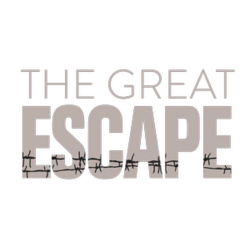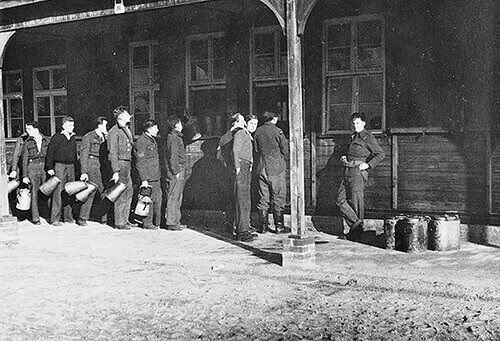
About the Great Escape
The mass breakout of Allied airmen from Stalag Luft III, a high security prison camp run by the Luftwaffe, in March 1944, is significant for the sheer impact it had on the Nazi leadership and the way in which it embodied the will of Allied prisoners of war to resist Hitler's tyranny.

A group of PoWs hold various jugs and pots as they queue for their water ration outside a large hut at Stalag Luft III.
The 'Great Escape' as it became known – which was immortalised in the 1963 Hollywood film of the same name – involved 600 men incarcerated in the north compound of Stalag Luft III at Sagan in south-east Germany.
The tunnels
In 1943, under the leadership of Squadron Leader Roger Bushell, known as Big X, the prisoners started digging three large tunnels known as 'Tom', 'Dick' and 'Harry', all emanating from huts in the compound. The tunnels were 30ft deep in an attempt to avoid German detection and were designed to run more than 300ft into woods outside the camp.
The prisoners begged, borrowed and stole equipment that enabled them to line the tunnels with wood, run a railway and electric lighting from entry to exit and ventilate the tunnels with primitive air conditioning. They also made civilian clothes, maps, compasses and German passes to help them escape.
According to German accounts after the escape, the materials missing from the camp included:
- 4,000 bed boards
- 1,699 blankets
- 161 pillow cases
- 34 chairs
- 478 spoons
- 30 shovels
- 1,000 feet of electric wire
- 600 feet of rope
- 192 bed covers
- 3,424 towels
All this was done in secret amid a fantastic security operation policed by the prisoners.
All went well for several months, but then tunnel Tom was discovered in September 1943 just as it reached the woods. Dick was abandoned for storage, but the prisoners pushed on with Harry, which was ready in early 1944.
On the night of March 24-25, 76 RAF officers broke out of the camp. A few hours later it was being discussed by Hitler and the German High Command. The Fuhrer demanded retribution.
The aftermath
Seventy-three officers were recaptured and 50 of these were shot by the Gestapo in what was one of the greatest war crimes committed by Nazi Germany against British servicemen during the course of the Second World War.
Three officers made it back to Britain, where there was outrage over the killings.
The British demanded that the killers be hunted down and brought to exemplary justice. After the war, they kept their word and many of the killers were punished by Allied courts.
While the film, starring Steve McQueen represents composites of the men involved, and draws on the experience of a number of different escapes, it is true to the spirit of events in the north compound and the character of many of the men involved.